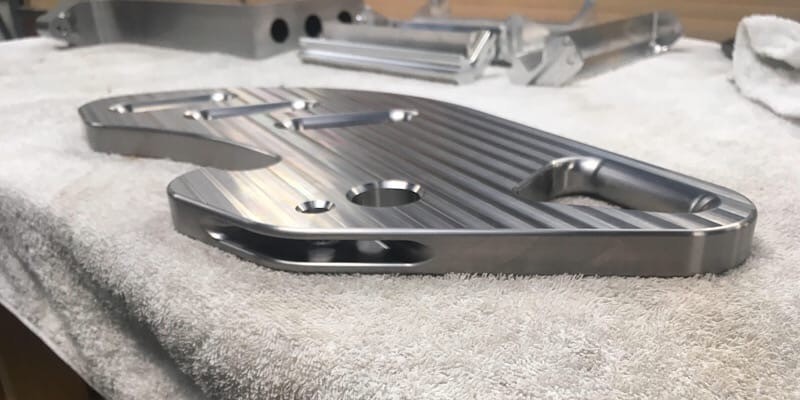- September 1, 2023
Titanium is a remarkable CNC machining material. It can withstand high temperatures and is resistant to chemical corrosion. Besides, it is lightweight with several other qualities, making it unique and desirable for manufacturers.
CNC machined titanium parts are extremely durable, but it can be challenging to machine titanium due to its high tensile strength. In this article, we will provide great information on CNC machining titanium, how to choose the right cutting tools for machining titanium, and useful tips to ensure successful machining.
Why Choose Titanium for CNC Machining Parts?
The key benefits of CNC titanium as a manufacturing material include its superior biocompatibility, high degree of corrosion resistance, and the highest strength-to-weight ratio of any metal. This metal also has excellent ductility and good machinability. Other reasons to choose titanium for CNC machining parts include:
- Durability: Titanium is highly durable and ideal for manufacturing CNC machined parts subjected to harsh or extreme working conditions.
- Non-magnetic: This metal has no magnetic characteristics. It also has excellent oxidation resistance, consequently making it resistant to corrosive forces.
- Non-toxic: Titanium is corrosion-resistant, has high bio-compatibility and non-toxic properties making it ideal for use in the medical industry.
These qualities of titanium give it application in various industries, including the aerospace, medical, and automotive industries.
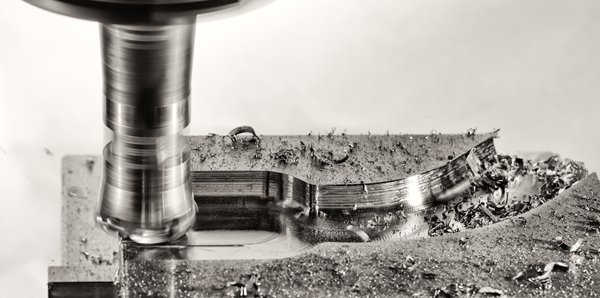
Challenges to Consider When Machining Titanium
Although CNC titanium is a great material for many uses, manufacturers often experience challenges when machining it. These challenges include;
High Chemical Reactivity and Galling
When machining titanium alloys, some gasses can react with them, leading to issues like surface oxidation and embrittlement. It may weaken the components and reduce their corrosion resistance.
Besides, this metal has a low modulus of elasticity compared to its high strength, consequently making it a gummy material to machine. Being gummy, titanium may adhere to the CNC cutting tool, resulting in failure and damage. Aside from tool damage, galling often compromises the surface finish quality of titanium.
Heat Buildup and Cutting Forces
Maintaining a cool temperature while machining titanium is one of the hardest challenges. The reason is that titanium has a low thermal conductivity, which causes the metal workpiece to build up heat where the tooling is fast. This wears out faster and could negatively impact the quality of cut surfaces if it is not handled, especially when machining harder titanium alloys.
Using a bigger chip load and a lower RPM on the CNC machine is essential for these tougher titanium alloys. A high-pressure coolant can also help your cutting tools work more efficiently and create titanium pieces of higher quality.
Also, titanium alloys need high cutting forces, which makes them difficult to cut. These cutting forces often cause tool wear, faulty parts, and high vibration, consequently impacting product quality and surface finish.
Residual and Hardening Stresses
Due to their crystal structure, titanium alloys are not extremely flexible, which might lead to issues during machining. Their crystal structure might increase cutting force during machining, decreasing machining ease and increasing the chances of residual tensions. These tensions may cause the position to twist, crack, or last less time.
Useful Tips for Titanium Machining
Many machine shops hesitate to work with this cutting-edge material because of the difficulties of titanium machining. However, due to its exceptional qualities, many manufacturers are opting to use titanium to produce high-quality parts. Fortunately, skilled CNC machinists and tool manufacturers have developed useful tips on machine titanium.
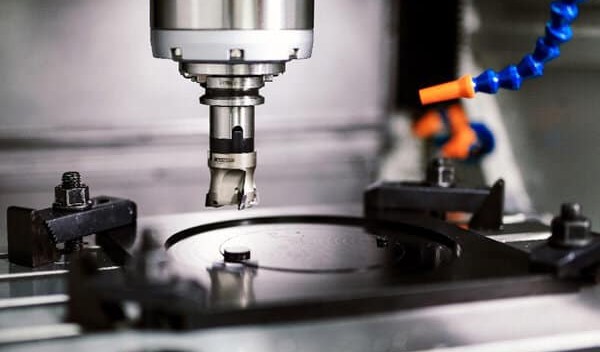
Fasten Parts Securely
Anything you can do to lessen vibration will make machining titanium easier because titanium is already prone to creating tool chatter. To prevent deflection in the workpiece, fasten parts securely. Additionally, utilize top-notch CNC machines with extremely rigid tooling arrangements. To minimize tool deflection, you may even consider adopting shorter cutting tools.
Choose the Right Cutting Tool
Due to the rising demand for titanium, tool makers are developing novel strategies to increase titanium’s machinability. Cutting tools with coatings made of titanium carbo-nitride (TiCN) or heat-resistant titanium aluminum nitride (TiAlN) can last longer.
Overall, machinists should pick titanium-specific tools of superior quality and regularly inspect and replace worn-out equipment. Also, consider using a tool with a smaller diameter and more cutting edges to help ensure the workpiece removal rate remains steady while limiting heat buildup.
Consider Cutting Parameters
Temperature control must be used carefully when machining titanium. Applying steady, high-pressure coolant directed at the cut region is one of the most straightforward ways to keep the workpiece and tooling cool. The chips won’t stick to your machining tools if you blast them out of the cut region.
Additionally, when working with titanium, it’s crucial to consider your feed rates, spindle speeds, and chip loads. This entails limiting the stress placed on tools and equipment and avoiding staying too long in one place. An alternate cutting strategy, such as increasing axial cut depth while decreasing radial engagement, may also be worth investigating to increase cutting effectiveness and lower machining temperatures.
Prevent Overheating By Using High-Pressure Cooling System
Titanium finishing demands a very tiny percentage of the tool’s radius to be in touch, a super-sharp, very little feed per tooth. But, it will lead to heat is difficult to remove from the work area. If left, it will eventually ruin our cutting tools, and heat effects will make maintaining tolerances challenging. Therefore, when cutting titanium, use the best coolant setup possible.
An effective aid is a high-pressure cooling system. A spindle could also be essential, depending on the application. Increasing coolant concentration may also prove beneficial when working with titanium.
Different Titanium Grades for CNC Machining
There are different grades of titanium and types of titanium alloys, each with its ideal application, merits, and demerits. Let’s examine these grades in detail.
Grade 1 (Pure Titanium with low oxygen content)
Among the most frequently utilized titanium types, this one is the softest and most ductile titanium alloy. Grade 1 titanium has excellent machinability, impact toughness, corrosion resistance, and formability. On the downside, it is lower in strength when compared to other grades of titanium. This grade finds application in the medical, automotive, and aerospace industries.
Grade 2 (Pure Titanium with standard oxygen content)
This is also known as workhorse titanium. It has high corrosion resistance, strength, formability, weldability, ductility, and low strength. Grade 2 titanium finds application in the medical and aerospace industries for producing aircraft engines.
Grade 3 (Pure Titanium with medium oxygen content)
Although not as commercially popular as grades 1 and 2, this titanium has good mechanical properties. It has a high corrosion resistance as well as machinability and strength. It finds application in the medical, marine, and aerospace industries.
Grade 4 (Pure Titanium with high oxygen content)
This grade of titanium has high strength and corrosion resistance. However, it isn’t easy to machine, often requiring high quantities of coolant and feed rate. Grade 4 titanium finds application in cryogenic vessels, CPI equipment, airframe components, heat exchangers, etc.
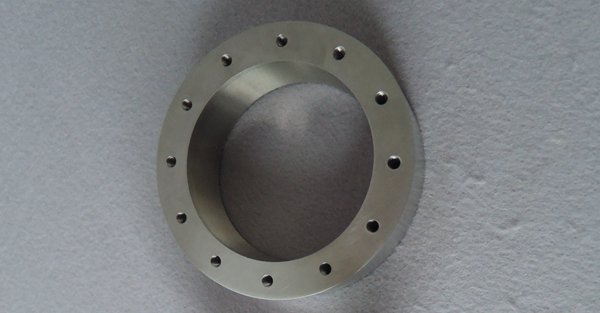
The above Grades 1-4 are all pure titanium, the next section is about the different grades of titanium alloy.
Grade 5 (Ti6Al4V)
Grade 5 titanium alloy contains 4% vanadium and 6% aluminum. It is not as strong as other alloys but has high corrosion resistance and formability. It is ideal for power generation, offshore and marine applications, and critical airframe structures.
Grade 6 (Ti 5 Al-2.5Sn)
This titanium grade has good stability, strength, and weldability, especially at high temperatures, which gives them application in the production of airframes and jet engines.
Grade 7 (Ti-0.15Pd)
This grade of titanium is similar to grade 2, with the only difference being its palladium content, added to improve its corrosion resistance. Grade 7 titanium alloy has excellent formability and weldability. It is ideal for use in producing chemical processing equipment.
Grade 11 (Ti-0.15Pd)
Grade 11 titanium is quite similar to grade 7. However, it is more ductile, with a lower tolerance for other impurities. It has a lower strength than grade 7 and finds application in the marine and chlorate manufacturing industry.
Grade 12 (Ti0.3Mo0.8Ni)
Grade 12 titanium is quite expensive and contains 0.8% nickel and 0.3% molybdenum, giving it excellent weldability, strength at high temperatures, and corrosion resistance. It finds application in shell and heat exchangers, marine and aircraft components, etc.
Grade 23 (T6Al4V-ELI)
Also known as extra low interstitial or TAV-EIL, the grade 23 titanium shares similar properties to grade 5 but is purer. It has good fracture toughness, biocompatibility, and poor relative machinability. It finds use in the production of orthopedic pins, screws, surgical staples, and orthodontic appliances.
How to Choose the Right Cutting Tools for Machining Titanium?
Using any cutting tool when CNC machining with titanium is usually a bad idea. Here is how to choose the right cutting tools for milling titanium or when using other CNC machining techniques.
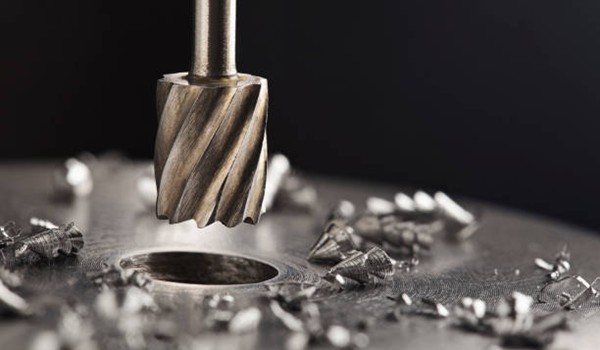
Take into Consideration the Cutting Tool’s Number of Flutes
You must increase the number of end mill flutes to get product cycle times. For titanium, more teeth equals less chatter. For instance, a 10-flute end mill, while tight for the chip loads ideal for most materials, is perfect for use with titanium. This is primarily due to the need to reduce radial engagements.
Avoid Interrupted Cuts and Keep Cutting Edge Sharp
Due to its low Young’s modulus, titanium is strong and elastic. This means that to efficiently and without rubbing remove a chip from the surface, we need a sharp tool.
Avoid interrupted cuts as much as possible since they can hammer chips into your sharp-edged tools, possibly leading to early tool failure.
Take Cutting Tool Coating into Consideration
Coatings can greatly improve your tooling’s capacity to endure the heat produced by titanium. TiAlN (Titanium Aluminum Nitride) is a suitable coating to consider. It imparts lubricity to combat built-up edges, galling, and chip welding and is especially well suited to the temperatures experienced in machining.
Try High-Feed Mills when Machining Titanium
High-feed mills are suitable for keeping engagement low when working with axially and radially titanium. These tools are specifically made to perform that task effectively.
Surface Finishes for Machined Titanium Parts
A range of surface finishing techniques, including titanium polishing, can enhance CNC machined titanium products for functional and aesthetic reasons. These surface finishes include:
- Polishing
- Anodizing
- Chroming
- Powder Coating
- PVD coating
- Brushing
Applications of Titanium Machined Parts
Titanium-machined parts are durable, corrosion-resistant, and aesthetic. These qualities give them applications in a variety of industries.
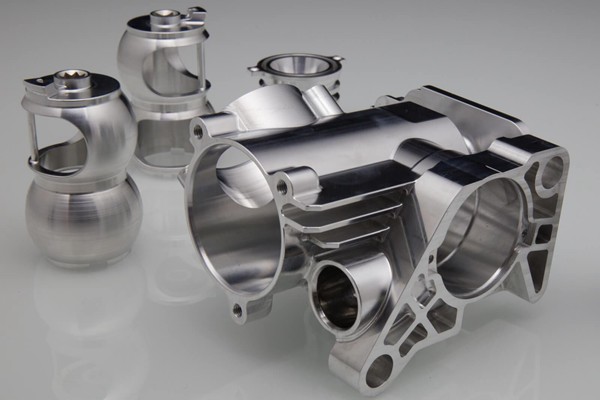
Marine/Naval Industry
Compared to most naturally occurring metals, titanium has a higher corrosion resistance. This resistance makes it ideal for producing propeller shafts, underwater robotics, rigging equipment, ball valves, marine heat exchangers, fire system piping, pumps, exhaust stack liners, and onboarding cooling systems.
Aerospace
Due to its numerous desirable qualities, titanium is a sought-after material in the aerospace industry. These qualities include its high strength-to-weight ratio, outstanding resistance to corrosion, and capability in extremely hot environments. Titanium parts in the aerospace industry include seat components, turbine components, shaft, valve, housing, and filter parts, as well as parts for oxygen generation systems.
Automotive
In the automotive sector titanium vs aluminum is an ever-raging argument, with aluminum having the upper hand due to its availability and cost effectiveness. Nonetheless, titanium is still found in the production of automotive parts. The main automotive uses for titanium and its alloys are production in the valves, valve springs, retainers, car stop brackets, hanging ear nuts, engine piston pins, suspension springs, brake caliper pistons, engine rockers, and connecting rods of engines with internal combustion.
Medical and Dental
The medical industry finds several applications for titanium due to its high corrosion resistance, low electrical conductivity, and physiological pH values. Parts made from titanium used for the medical industry include tapered, straight, or self-tapping bone screws, dental implant screws, cranial screws for cranial fixation systems, spinal fixation rods, connectors and plates, orthopedic pins, etc.
Choose WayKen for Machining Titanium Parts
WayKen is an expert CNC machining company, with a great specialty in machining titanium. We offer high-quality CNC machining titanium services to industries at highly competitive prices. With 5-axis machining and precision machine equipment, our team of designers and engineers is always ready to take and process your order in the shortest time possible, reducing time to market.
Conclusion
Titanium and its alloys require careful machining for optimal part production. It is a metal much different from its counterparts like steel and brass. It requires the use of correct tools, expertise, and patience. This is why it is often best to outsource Titanium CNC machining projects to professionals like WayKen, who guarantee high-quality parts with precision.
FAQs
Is titanium harder to machine than steel?
Titanium is harder to machine than steel, primarily due to its high melting point. It is also very malleable and often stretches before breaking, making it harder to machine.
What is the feed rate of milling titanium?
When working with titanium, this insert should be cut at a speed of 40 to 150 m/min with a feed rate of 0.03 to 0.15 mm per tooth.
How do you stress relief titanium after machining?
Stress relief techniques can be used on titanium alloys without compromising their ductility or strength. Forgings are produced by heating metal to temperatures between 595 and 705 °C (1100 and 1300 °F) for one to two hours before air cooling.

